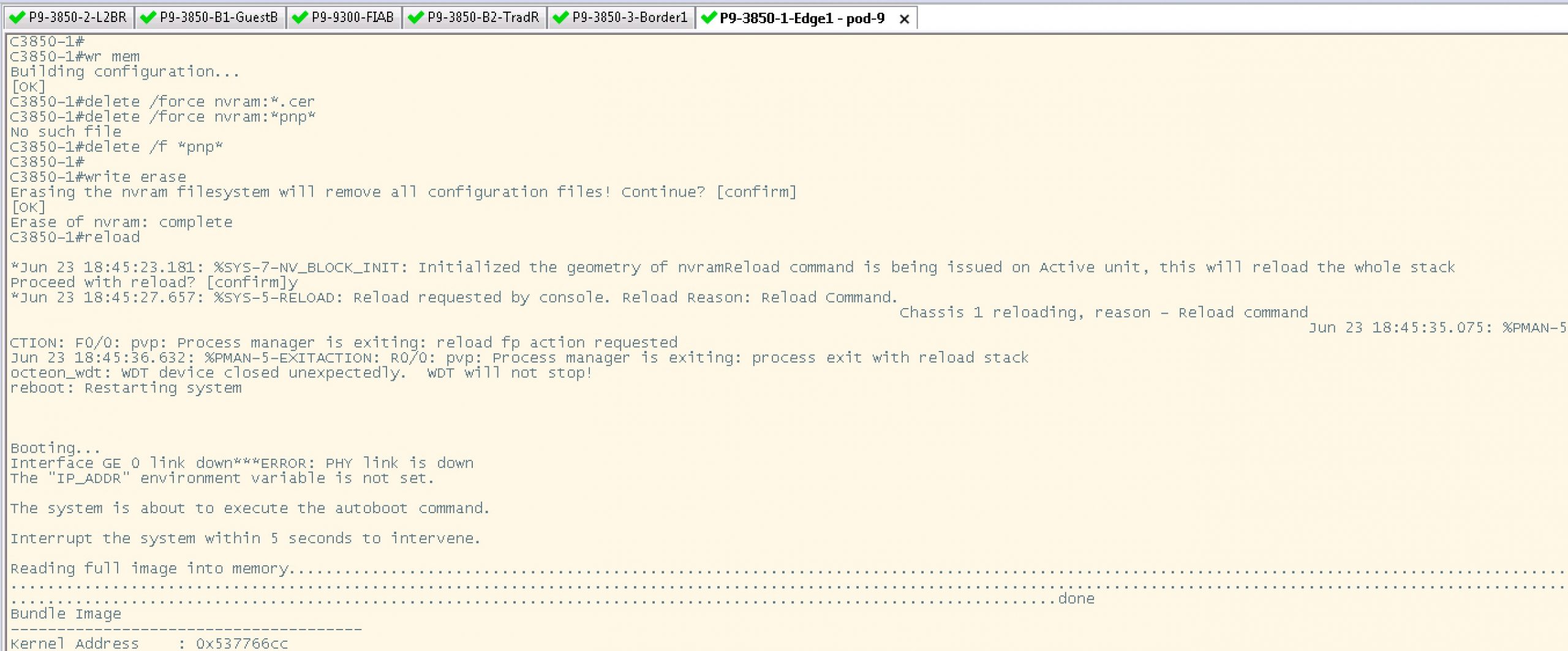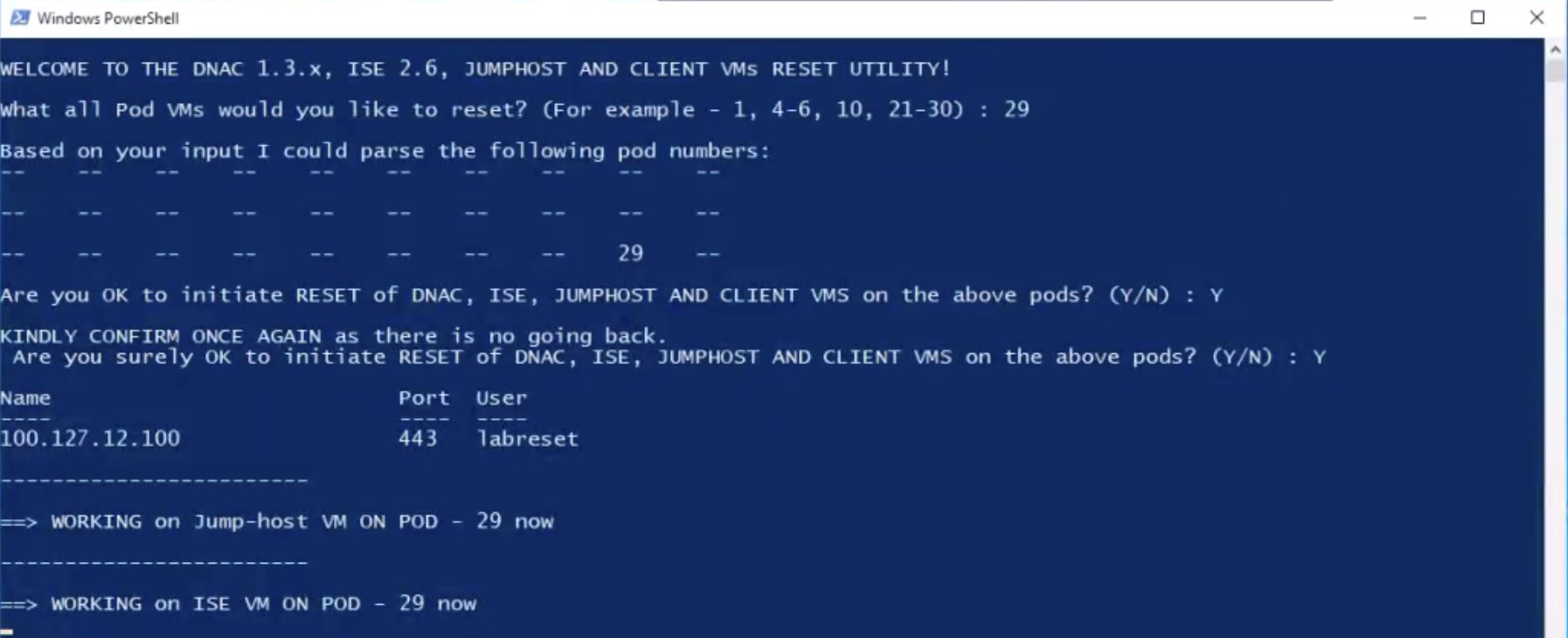Cisco’s Intent-Based Networking (IBNG) Innovation Team is responsible for providing training labs, bootcamps and demos for customers, partners, internal sales at individual and public events. After each training we have to reset hundreds of devices and multiple controllers like Cisco DNA Center, ISE, DHCP, WLC etc. This manual reset takes the team a lot of time. During some of our events, we are required to reset multiple times a week or daily. To minimize the manual work and be more efficient, we created some API based tools that can complete the whole process in less than 30 minutes.
If you have any requirement for similar use cases, you can try our API-based tools that can save you time and reduce the tedious work!
We have 20-30 pods in each training lab. A pod is an individual testbed that contains different devices, such as edge/access, distribution and core devices. These devices mimic a small customer Enterprise environment, with Catalyst3k and 9k switches, ASR and ISR routers and wireless controllers. During the lab, the devices are configured per various use cases. Post each event, the devices need to be brought back to the beginning state. With the help of the APIs and scripts, we automated this reset process.
API-based Tools
For resetting devices such as Cat9ks, Cat3ks, ASRs and ISRs we are using SecureCRT APIs which can reset the device to a default state or configure the device to a base state. Using these scripts if a switch is in configuration mode, enable mode or in any other mode it will do necessary configuration changes and do the reset on the devices. Sometimes after reset we want to provide additional configuration that is not part of the base. For that we will use another script which can simultaneously run on multiple devices.

We also created a button bar in secure CRT and pointed the script to this button. This button bar is a quick way to run scripts, send strings and issue protocol commands on multiple sessions simultaneously. Step by step instructions for configuring this button can be referred here. Whenever we want to execute a script on any number of sessions just clicking on the button will execute the script on all the sessions opened. The following is an example for mapping a python script to a button in a button bar. All the links to these scripts is referred in What Next? section.

Next step is to reset Cisco DNA Center. For Cisco DNA Center, we are using Cisco DNA Center internal APIs to perform the backup and restore operations. We can also use these APIs to check the status of backups and restoration operations. Currently backup/restore APIs are for internal purposes only, these will be published in future. We also integrated these backup/restore scripts with Webex teams. So, if you execute any backup or restore script it will send a notification to the Webex teams and everyone in that Webex group will be aware of the changes.

Next step is to reset other controllers such as ISE/DHCP/DNS/Cat9800. We installed these controllers as VMs on ESXI hosts. To reset these VMs, we are using the snapshots and non-persistent modes for the VMs. Using the PowerCLI cmdlets we are creating new VMs from the snapshots and resetting the VMs for non-persistent mode. The following is an example to reset the controllers and create VMs from snapshots. All the links to these scripts is referred in What Next? section.

Monitoring API-Based Tools
After the reset process has completed, we are also monitoring the devices by using python applications. If something happens to the device, such as a link or switch goes down, we will be notified in Webex Teams of this issue. We integrated Cisco DNA Center with Webex teams and configured the events on Cisco DNA Center to notify us of these alerts. If any issue happens, we will get a notification in the webex teams as alert. The following is an example for the switch unreachable notification in Webex teams that DNAC has sent via APIs.

The following is an example to subscribe to an event in Cisco DNA center and provide receiver details for sending the alerts. You can subscribe to specific events that may occur in your network. After your subscription, if the event does occur you will receive a notification by REST APIs. You can refer here for more details on how to subscribe to events.

What Next?
Using these API tools, you can automate lab and demo reset processes and configure the devices or controllers to a base state while also monitoring the devices to receive notifications via webex teams for any issue.
Refer to SecureCRT scripts for device reset and configuration, scripts for resetting and cloning VMs such as ISE, CSR1k and clients and DNAC webhook receiver scripts for monitoring the devices from DNAC.
Related resources
- Visit the DevNet Networking Dev Center to learn more about device level APIs
- Learn more about Cisco’s professional DevNet Certifications
We’d love to hear what you think. Ask a question or leave a comment below.
And stay connected with Cisco DevNet on social!
Twitter @CiscoDevNet | Facebook | LinkedIn
Visit the new Developer Video Channel

Hi Krishna, wow, this is a great example showing the power of integrating various API’s in various products to significantly reduce lab reset times. Now focus can be on innovating further, instead of repeating a manual or error-prone process. Do you think that the gNOI reset.proto API might come in handy in the future for this type of use case?
Hi Jeremy, thank you. I didn’t tried with gNOI yet but I will work with you and we can develop this use case integrating with various APIs.